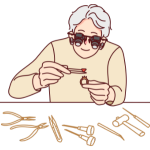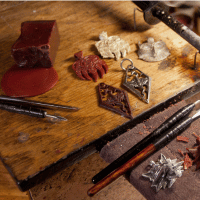Lost wax casting is a dance – a careful balance between technique, artistry, and materials. But what if you’ve mastered the steps, yet your dance partner – the materials – isn’t up to par? With the right resources, this ancient method can produce jewelry pieces that aren’t just beautiful, but enduring.
Journey with us as we traverse the globe, highlighting the best spots to find those impeccable materials that can elevate your lost wax casting creations to the next level. So, where does one find these elusive, top-grade supplies? Let’s uncover the secrets together.
Material & Tool Source Guide
| Category | Material/Tool | Description | Recommended Suppliers | Notes |
| Metal | Gold, Silver, Bronze, etc. | Type of metal for casting | Johnson Matthey, Stuller, Rio Grande, Cooksongold, Metalor | Ensure certification of purity |
| Wax | Hard Waxes, Soft Waxes, Specialty Waxes | Type and use of wax in casting | Kerr, Ferris File-a-Wax, Contenti | Consider eco-friendly options |
| Casting Supplies | Investment, Crucibles | Essential for the casting process | R&R’s Ultravest, Dixon, Borax | Ensure high temperature resistance |
| Online Shopping | N/A | Online platforms for materials | Rio Grande, Cookson Gold | Always check user reviews |
| Eco-Friendly Options | Recycled Metals, Natural Waxes | Sustainable choices | Hoover & Strong, GreenTree Naturals | Supports reduced carbon footprint |
Essential Tools and Supplies: What and Where to Buy
Lost wax casting is an intricate process that goes beyond just wax and metals. Over the years, having been closely involved with the craft, I’ve discovered the importance of having the right tools and supplies. Each component, no matter how insignificant it may seem, plays a vital role in ensuring the success of the final product. Let’s explore the essentials.
Metals Fit for the Craft: Gold, Silver, Bronze and Beyond
The choice of metal isn’t just about aesthetics; it dictates the durability, value, and workability of the piece.
- Gold: Prized for its lustre and resistance to tarnish, gold remains a favorite in the industry. It comes in various alloys, giving rise to different colors, from rose gold to white gold. Reliable suppliers such as Johnson Matthey and Stuller provide gold suited for lost wax casting.
- Silver: This white metal, with its high thermal conductivity, offers a brighter and more reflective finish. I’ve often sourced quality silver from Rio Grande and CooksonGold, and they’ve never disappointed.
- Bronze: An alloy of copper and tin, bronze gives a rustic, antique finish that’s much sought after for vintage designs. I’ve found Metalor to be an excellent source.
- Beyond: Palladium, platinum, and even brass are also employed, broadening the horizons of creativity. It’s essential to source from established vendors, ensuring that the metal’s purity aligns with your project’s requirements.
The Role of Wax: Types and Best Sources
Wax serves as the primary mold in the lost wax casting process. Its malleability allows for intricate models, which are later replaced by molten metal.
- Hard Waxes: These are used for creating thin sections of a model, offering minimal shrinkage. Kerr’s Inlay Wax is a personal favorite for its superior quality and finish.
- Soft Waxes: Suited for building up bulk sections of a model, they’re easily carved and manipulated. For those diving into lost wax casting, I’d recommend starting with the Ferris File-a-Wax range.
- Specialty Waxes: These include filler and repair waxes. Over the years, Contenti has been my go-to for these specific varieties.
Crucial Casting Supplies: From Investment to Crucibles
The final piece’s quality is often determined by the auxiliary materials and tools employed.
- Investment: This refractory material forms a mould around the wax model. The quality is paramount, as it must withstand high temperatures without breaking down. R&R’s Ultravest has consistently delivered top-notch results for me.
- Crucibles: These containers, typically made of clay or graphite, hold the molten metal. Depending on the metal you’re working with, the crucible type can vary. I’ve sourced durable crucibles from suppliers like Dixon and Borax.
- Other Supplies: Tongs for handling hot crucibles, burnout ovens for melting out the wax, and quenching buckets are equally vital. Over time, I’ve built a trusted toolkit, predominantly from suppliers like Rio Grande and local specialty shops.
Being deeply immersed in the craft of lost wax casting, I’ve come to appreciate the nuances and intricacies of each step. The right materials can elevate your work, so invest wisely and source responsibly.
Finding Responsible Vendors
In the intricate world of lost wax casting, the quality and origin of your materials can make or break the success of your final product. Over the years, I’ve navigated the vast marketplace of vendors, understanding the critical importance of sourcing responsibly. From eco-friendly options to weighing quality against expense, the journey of finding the right supplier is an art in itself.
Eco-Friendly Material Choices
My commitment to sustainability has led me to prioritize eco-friendly materials in my creations. More than just a trend, responsible sourcing safeguards our planet for future generations.
- Recycled Metals: Several suppliers now offer metals sourced from recycled jewelry or electronic components. This not only reduces mining impact but ensures a lower carbon footprint. Companies like Hoover & Strong have been pioneers in providing recycled metals of exceptional quality.
- Natural Waxes: Opting for biodegradable waxes, free from harmful additives, not only benefits the environment but also ensures a cleaner burnout. Brands like GreenTree Naturals have been at the forefront of sustainable wax production.
Global Hotspots for Casting Supplies
Traveling and exploring have introduced me to global markets teeming with materials. Each region offers unique specialties that cater to different casting needs.
- India: Renowned for its gem markets and metal craftsmanship, Jaipur has been a frequent stop for sourcing semi-precious stones and local metal alloys.
- Italy: The workshops of Florence, with their centuries-old jewelry traditions, provide exceptional quality gold and bronze suitable for casting.
- Thailand: Bangkok is a hub for silver, with suppliers offering a blend of traditional and modern alloys that are both durable and lustrous.
Online Material Shopping
The digital era has opened up global marketplaces, bringing materials to one’s doorstep with a click. While convenient, it’s crucial to navigate these platforms with caution.
- Trusted Platforms: Over the years, I’ve come to rely on platforms like Rio Grande and CooksonGold, which guarantee both quality and authenticity.
- User Reviews: Before venturing into a new online store, I always dive deep into user reviews. These testimonials often provide genuine insights, revealing both the strengths and pitfalls of a vendor.
Weighing Quality against Expense
Craftsmanship is undoubtedly an investment, but it doesn’t always mean breaking the bank. Finding the balance between quality and expense has been a continuous journey.
- Bulk Purchases: By purchasing materials like metals and waxes in bulk from wholesalers, I’ve often received substantial discounts without compromising on quality.
- Local Markets: Exploring local markets during my travels has often led to discovering materials of impeccable quality at competitive prices, especially in regions known for specific crafts.
Ensuring Genuine Supplies
The market is, unfortunately, riddled with counterfeit materials that can jeopardize the integrity of your creations.
- Certification: I always ensure that the metals I purchase come with a certification of authenticity, detailing their purity and origin.
- Gem Testing: When sourcing gemstones, I often resort to trusted gem testing labs to ascertain their genuineness. Over time, tools like loupe and refractometers have also become invaluable additions to my toolkit for on-the-spot assessments.
Finding responsible vendors is more than just a sourcing task—it’s a commitment to upholding the craft’s integrity and embracing sustainability. Through careful navigation and due diligence, each casting can be both a masterpiece and a testament to responsible craftsmanship.
Crafting with Care: Safety and Workspace Best Practices
Safety First: Protective Gear Essentials
Lost wax casting, while incredibly rewarding, involves high temperatures and potentially hazardous materials. Over the years, I’ve recognized the value of prioritizing safety in my workspace.
- Eye Protection: Safety goggles are crucial to protect the eyes from splashes of molten metal or shards from tools.
- Heat-resistant Gloves: A must-have when handling hot crucibles or pouring molten metal. Brands like Ansell offer gloves specifically designed for high-heat situations.
- Ventilation: Ensure your workspace is well-ventilated to prevent the inhalation of fumes, especially during the wax burnout phase. Investing in an exhaust system or working in an open space can be beneficial.
Organizing Your Workspace: Efficiency and Comfort
Maintaining a tidy and well-organized workspace isn’t just about aesthetics; it’s a key component in ensuring the smooth flow of the casting process and avoiding mishaps.
- Tool Organization: Use pegboards, tool racks, and labeled drawers to keep all your tools within arm’s reach and easy to locate.
- Designated Zones: Separate your workspace into designated zones for wax working, casting, and finishing. This not only increases efficiency but ensures that tools and materials don’t cross-contaminate.
Handling Materials: Storage and Disposal
Storing materials correctly can extend their shelf life, while responsible disposal underlines the ethos of sustainable crafting.
- Metal Storage: Store metals in a cool, dry place, preferably in sealed bags or containers to avoid oxidation.
- Wax Disposal: While many waxes are biodegradable, it’s important to dispose of them in eco-friendly manners, avoiding waterways or general waste where possible.
Incorporating these safety and organization measures ensures that your crafting experience is both productive and enjoyable. It not only optimizes your workflow but also ensures that you’re crafting in a sustainable and safe environment
FAQ Section
What metals are most commonly used in lost wax casting?
A: Common metals include gold, silver, and bronze. Each has its unique properties and ideal applications in the casting process.
Are there any eco-friendly alternatives to traditional casting waxes?
A: Yes, many brands now offer biodegradable waxes, which are free from harmful additives and provide a cleaner burnout.
How can I ensure the authenticity of the metals I purchase online?
Always ask for a certification of authenticity detailing the metal’s purity and origin. It’s also recommended to purchase from well-reviewed and trusted platforms.
What’s the significance of having an organized workspace in casting?
An organized workspace ensures a smooth workflow, minimizes risks of accidents, and enhances efficiency by reducing the time spent searching for tools or materials.
How do I safely dispose of materials used in lost wax casting?
Store metals in sealed bags to prevent oxidation. For waxes, avoid disposing them in waterways or general waste. Some can be biodegraded or recycled, depending on the type.
Conclusion
Lost wax casting is a blend of artistry and precision, where the quality of materials and tools play a pivotal role. By sourcing responsibly, prioritizing safety, and cultivating an efficient workspace, artisans can craft masterpieces that stand the test of time. As the world becomes more interconnected, the options are vast; yet, careful navigation and due diligence remain the hallmarks of exemplary craftsmanship.



Leave a Reply